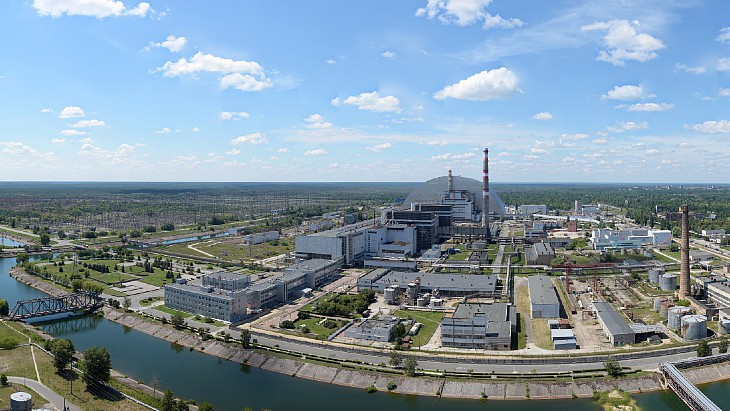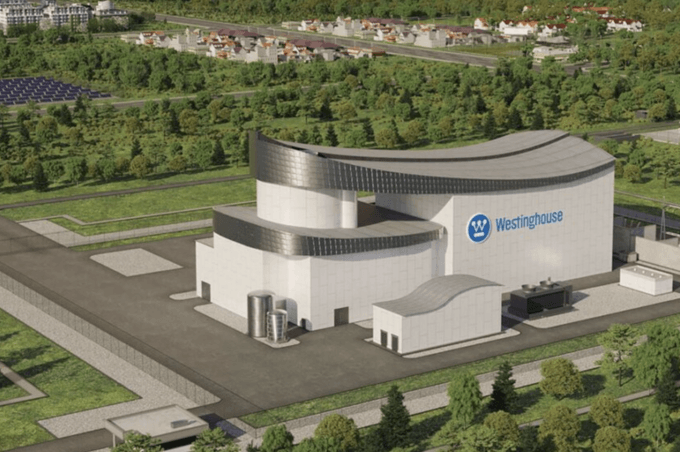OPG wraps up Darlington 1 refurbishment early
Refurbishment activities have been completed five months ahead of schedule at the third of four nuclear units to undergo the process at the Ontario Power Generation plant, which will soon be reconnected to the grid.
_42839.jpg)
The 875 MWe unit was taken offline for refurbishment in February 2022, following units 2 and 3, which completed refurbishment in 2020 and 2023, as part of a 10-year CAD12.8 billion (about USD9.7 billion) mega-project to refurbish all four Candu units at the site. The final unit undergoing refurbishment, unit 4, is currently in the reactor rebuilding phase, and is on schedule to be completed by the end of 2026.
Separately, the Canadian Nuclear Safety Commission (CNSC) announced it has removed the fourth and final regulatory hold point for the Darlington 1 refurbishment, allowing Ontario Power Generation (OPG) to exceed 35% full operating power for the refurbished reactor and proceed with normal operations. Hold points are mandatory checkpoints where CNSC approval is required before the licensee can move on to the next stage of the process to return the unit to operation.
The refurbishment will allow the units to continue generating electricity for a further 30 years. In addition, unit 1 will become the first Darlington reactor to produce cobalt-60, a vital radioisotope whose uses include sterilising single-use medical devices, such as syringes, implants, and surgical instruments. About half of the global supply of the isotope is produced in Ontario's Candu reactors.
"With the refurbishment of another unit, OPG, our employees, and our project partners continue to demonstrate that we can execute major nuclear projects not only on time, but ahead of time, and with a clear commitment to quality," OPG President and CEO Ken Hartwick said. "This latest milestone reflects our decade of preparation and planning, as well as our dedication to quality and innovation, and the hard work of our entire project team, vendors, skilled trades, and energy professionals."
"Ontario needs more electricity - 75% more by 2050 - to power new homes, historic new investments and an electrifying economy," the province's Minister of Energy and Electrification Stephen Lecce said. "Delivering this massive clean energy project five months ahead of schedule is a testament to the incredible knowledge and skill of Ontario workers and positions us for success as we build out our plan to meet the soaring energy demand over the next 25 years."
According to a report by the Conference Board of Canada, the Darlington refurbishment project and the subsequent 30 years of station operation are expected to generate a total of CAD90 billion in economic benefits for Ontario and create 14,200 jobs per year.
Norway SMR options to be explored with X-energy
Norsk Kjernekraft has signed a memorandum of understanding with high-temperature gas-cooled pebble-bed nuclear reactor developer X-energy to explore the deployment of small modular reactors in Norway.
_34629.jpg)
The memorandum of understanding also encompasses DL Energy and DL E&C, from South Korea's DL Group, who signed a collaboration agreement with Norsk Kjernekraft in August. The Norwegian company said the aim was to combine the Korean firm's expertise and experience in building nuclear power facilities with the US-based X-energy's reactor technology.
The August agreement included a feasibility study of constructing a nuclear power plant at the Mongstad oil refinery in the Austrheim and Alver municipality, with the Norwegian firm aiming for such a plant to be built by the mid-30s if there is "political will". In August Norsk Kjernekraft also submitted a proposal to Norway's Ministry of Energy for an assessment of the potential construction of a power plant based on multiple SMRs in the municipality of Øygarden, west of Bergen. That proposal followed proposals submitted for SMR power plants in Aure and Heim municipalities, as well as Vardø municipality.
Last month internet shopping and web services giant Amazon announced it was taking a stake in X-energy with the goal of deploying up to 5 GW of its small modular reactors in the USA by 2039.
Jonny Hesthammer, CEO of Norsk Kjernekraft, said: "South Korea has extensive experience in the efficient construction and operation of nuclear power plants, while the US has the leading technology. The recent investment by Amazon, one of the world’s largest companies, in X-energy underlines the importance of this agreement. This is simply because it increases the chances of succeeding. While the SMRs to be developed by X-energy are considered fourth generation, the technology is well-proven. Their use of TRISO fuel in the form of tennis ball-sized pebbles means that meltdown is not possible, something that many worry about."
Alistair Black, Senior Director for X-energy, said: "We’re delighted to be working with DL Energy to assess the potential for an Xe-100 advanced small modular reactor project in Southwest Norway for the nuclear development company Norsk Kjernekraft. We have projects under way in the US and could help Norway decarbonise its industrial sector and transport network and meet growing electricity demand from the booming artificial intelligence and cloud computing sectors."
In June, the Norwegian government announced the appointment of a committee to conduct a broad review and assessment of various aspects of a possible future establishment of nuclear power in the country. It must deliver its report by 1 April 2026.
X-energy's Xe-100 is a Generation IV advanced reactor design which X-energy says is based on decades of high temperature gas-cooled reactor operation, research, and development, and is designed to operate as a standard 320 MWe four-pack power plant or scaled in units of 80 MWe. At 200 MWt of 565°C steam, the Xe-100 is suitable for a range of uses and power applications including mining and heavy industry. The Xe-100 uses tri-structural isotropic (TRISO) particle fuel, which has additional safety benefits because it can withstand very high temperatures without melting.
X-energy says its design makes it road-shippable with accelerated construction timelines and more predictable and manageable construction costs, and is well suited to meet the requirements of energy-intensive data centres.
Generator stator arrives at Hinkley Point C
The turbine generator stator for the Hinkley Point C nuclear power plant under construction in Somerset, England, has been delivered from the manufacturing plant in Belfort, France.
_53163.jpg)
The stator - measuring 12 metres in length and weighing 450 tonnes - was supplied by EDF subsidiary Arabelle Solutions. It was delivered to the construction site on 17 November following a journey via road, rail and sea.

(Image: EDF Energy)
The stator is a key component of the turbine generator, serving as the stationary portion of an electric generator that converts the rotating magnetic field into electric current.

(Image: EDF Energy)
EDF completed its acquisition of a portion of GE Vernova's nuclear conventional islands technology and services, including its Arabelle steam turbines, in May this year. The transaction included the manufacturing of conventional island equipment for new nuclear power plants as well as related maintenance and upgrade activities for existing nuclear plants outside of the Americas. EDF's acquisition of the business - at that time, known as GE Steam Power - was first announced in early 2022 and the final agreement was signed in the November of that year.
Construction of Hinkley Point C - composed of two EPR pressurised water reactors of 1630 MWe each - began in December 2018, with unit 1 of the plant originally scheduled to start up by the end of 2025, before that was revised to 2027 in May 2022. In January, EDF announced that the "base case" was now for unit 1 being operational in 2030, with the cost revised from GBP26 billion (USD32.8 billion) to between GBP31-34 billion, in 2015 prices.
When complete, the two EPR reactors will produce enough carbon-free electricity for six million homes, and are expected to operate for as long as 80 years.
SMRs to help decarbonise Dutch energy system, study concludes
Small modular reactors could play an important role and contribute to the Dutch energy transition, a joint report by NRG-Pallas and TNO concludes. The study shows that there is room for more than 13 SMRs in 2050.
_19078.jpg)
The study, the partners said, utilises "NRG-Pallas' expertise in innovative reactor technologies and TNO's energy system model OPERA".
Two scenarios drawn up by TNO were used in this study: ADAPT and TRANSFORM. These scenarios are based on different visions of the future for the Dutch energy system. In both visions, the aim is to reduce greenhouse gas emissions by 55% by 2030 and to achieve greenhouse gas neutrality by 2050.
In order to investigate the sensitivity of the results with respect to boundary conditions and assumptions, a few 'what-if' analyses were performed. These what-if analyses examined whether investment in and use of SMRs change when input parameters are varied.
"The results show that SMRs have a role to play in the Dutch energy transition," the study says. "The optimal contribution of SMRs to 2050 was calculated for various assumptions about future society. The results show that two to more than 13 SMRs (of 150 MWe) can be deployed with room for further expansion of this number in 2050."
It adds: "These results are contingent on policy objectives, expected market availability and realisation periods. If constraints on the potential deployment capacity are partially lifted, as is done in some of the what-if analyses, it is observed that there may even be room for more than 27 SMRs (of 150 MWe). This what-if analysis result can be interpreted as a more economically optimal solution, but is obviously conditional on the aforementioned aspects used to define the potential limits for the scenarios being sufficiently adjusted to allow for this to occur.
"On the other hand, with delayed introduction of SMRs or no nuclear at all, a carbon neutral energy system in 2050 is possible as well. The exact optimum depends mainly on the future of industry, and more specifically on the future heat demand from activities such as refineries and (bio-)aromatics production, and the degree of electrification in society. Nevertheless, it can be concluded that SMRs are an important option for decarbonisation of the industry by supplying process heat."
An earlier scenario study by TNO showed that in an energy system without new nuclear power plants, the system costs are 1% to 2.5% higher than with nuclear energy. "Although nuclear power plants are initially more expensive than wind turbines and solar panels, the loss of nuclear energy as an energy supply should be compensated for by greater use of more expensive flexibility options, such as energy storage," NRG-Pallas noted.
In April 2023, in its draft Climate Fund for 2024, the Dutch government budgeted funds totalling EUR320 million (USD352 million) for the development of nuclear energy. The funds will be used for the preparation of the operational extension of the existing Borssele nuclear power plant, the construction of two new large reactors, the development of small modular reactors and for nuclear skills development in the Netherlands.
In August 2022, the UK's Rolls-Royce SMR signed an exclusive agreement with ULC-Energy to collaborate on the deployment of Rolls-Royce SMR power plants in the Netherlands. ULC-Energy - established in 2021 and based in Amsterdam - aims to accelerate decarbonisation in the Netherlands by developing nuclear energy projects that efficiently integrate with residential and industrial energy networks in the country.
Chernobyl considered as site for new small modular reactors
The area around the Chernobyl nuclear power plant is one of the places being looked at as potential locations for Ukraine's planned future wave of small modular reactors.

Representatives of the State Agency of Ukraine on Exclusion Zone Management and specialists from Ukraine's nuclear energy giant Energoatom, joined Chernobyl Nuclear Power Plant (CNPP) officials last month to visit several areas within the exclusion zone and around the plant, CNPP reported. "This was followed by a technical discussion on the suitability of these sites for future SMR construction," it added.
It was the second on-site meeting to "review potential locations for small modular reactors (SMRs) proposed by Chornobyl NPP and discuss land allocation matters".
The Chernobyl nuclear power plant lies about 130 kilometres north of Kiev and about 20 kilometres south of the border with Belarus. Following the 1986 accident, a 30-kilometre exclusion zone was created around it. (Read more: World Nuclear Association's guide to the Chernobyl accident)
Ukraine's big plans for SMRs
Ukraine has plans for as many as nine new Westinghouse AP1000 large reactors across the country, as well as developing a programme for SMRs. Progress on its new nuclear has continued amid the on-going war with Russia, which has seen its largest nuclear power plant - Zaporizhzhia NPP - under Russian military control since early March 2022.
Energoatom signed an agreement last year which could pave the way for up to 20 of Holtec's SMRs. It has also been exploring options with a number of other potential SMR providers.
On Saturday at the COP29 UN climate conference in Baku, Azerbaijan, US Under Secretary of State for Arms Control and International Security, Bonnie Jenkins, and Ukraine Minister of Energy Herman Halushchenko announced three project partnerships:
- To build a pilot plant in Ukraine to demonstrate production of clean hydrogen and ammonia "using simulated safe and secure small modular reactor technology". The project is being carried out by a multinational public-private consortium from Japan, South Korea, Ukraine, and the USA.
- Project Phoenix funding to help facilitate the transition of Ukraine’s coal-fired power plants to SMR nuclear power plants, carrying out siting and feasibility studies.
- To develop a roadmap and provide technical support to rebuild, modernise, and decarbonise Ukraine’s steel industry with SMRs. The roadmap will pave the way for using clean electricity, process heat, and hydrogen from SMRs for clean steel manufacturing and production
The American Society of Mechanical Engineers (AMSE) said it would be working to support the clean steel programme, with CEO Tom Costabile saying: "Small modular reactors are an important part of the clean energy future, as well as an economic redevelopment opportunity for Ukraine."
Russia places 'tit-for-tat' ban on US uranium exports
Russia has announced restrictions on exports of enriched uranium to the USA. The temporary ban is in response to US restrictions on imports of Russian uranium products which came into force earlier this year.
_57190.jpg)
The Russian government announced the ban on its official website on 15 November as an amendment to Government Decree No 313 of 9 March 2022. It covers exports "to the United States or under foreign trade contracts concluded with persons registered in the jurisdiction of the United States". Exemptions will be made for deliveries under one-off licences issued by the Russian Federal Service for Technical and Export Control.
"The decision was made on the instructions of the President in response to the restriction imposed by the United States for 2024-2027, and from 2028 - a ban on the import of Russian uranium products," the Russian government said. "Vladimir Putin instructed to analyse the possibility of restricting supplies to foreign markets of strategic raw materials in September at a meeting with the Government."
According to the Tass news agency, Russian state nuclear corporation Rosatom said the ban was legal and the expected "tit-for-tat response to actions of the US authorities". Deliveries of Russian uranium to countries other than the USA "will continue without changes, on conditions agreed with customers and subject to requirements of national laws", Rosatom said.
Kremlin spokesperson Dmitry Peskov told Tass that "in cases where it serves our interests, Russia’s Federal Service for Technical and Export Control may decide to exclude certain items from this list of bans", but said the government had assessed the implications and consequences of the "absolutely reciprocal" countermeasures. "But the key point is that this should fully align with our interests and not undermine them. That is the basis for what has been done," he said.
US President Joe Biden signed the Prohibiting Russian Uranium Imports Act in May after the bill was passed unanimously by the US Senate. The prohibition came into effect in August, and will last until the end of 2040. Waivers may be granted to allow the import of limited amounts of Russian-origin LEU, under certain circumstances, until 1 January 2028.
US enrichment company Centrus received such a waiver from the US Department of Energy in July, allowing it to import low-enriched uranium from Russia for delivery to US customers in 2024 and 2025. Tenex - a Russian government-owned company - is Centrus' largest supplier of low-enriched uranium for delivery to its US and international customers pursuant to a 2011 contract.
Tenex has now notified Centrus that its general licence to export the material to the USA has been rescinded under the decree, "effective through December 31, 2025", and that it is now required to obtain a specific export licence from the Russian authorities for each of its remaining 2024 shipments to Centrus and for shipments in 2025.
"Tenex has informed Centrus of its plan to seek the necessary export licences, in a timely manner, to allow it to meet its delivery obligations for the pending Centrus orders," Centrus said in a filing to the US Securities and Exchange Commission. The US company said it will be in communication with its customers whose pending orders may be affected and is assessing actions to mitigate adverse impacts.
"If TENEX is unable to secure export licences for our pending or future orders, it would affect our ability to meet our delivery obligations to our customers and would have a material adverse effect on our business, results of operations, and competitive position," the company said.
According to US Energy Information Administration data, owners and operators of US nuclear power plants purchased a total of 51.6 million pounds U3O8 (19,848 tU) of deliveries from domestic and foreign suppliers in 2023. Most of this came from Canada (27% of total deliveries), Australia (22%) and Kazakhstan (22%): Russian-origin material accounted for 12% of total deliveries. Domestically produced material accounted for 5%. But while US facilities provided 28% of the uranium enrichment services - measured in separative work units, or SWU - purchased by US owners and operators in 2023, 27% came from Russia, more than any other foreign supplier.
_56424.jpg)

_17154.jpg)




